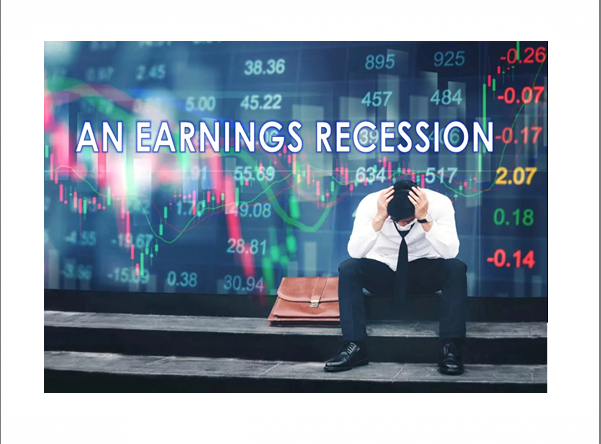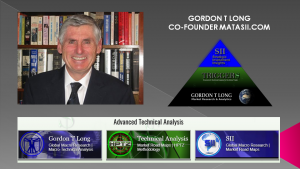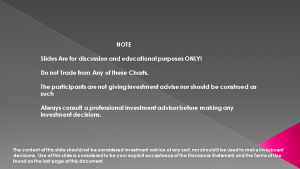IN-DEPTH: TRANSCRIPTION - LONGWave – 07-13-22 - JULY – An Earnings Recession
SLIDE DECK
TRANSCRIPTION
SLIDE 2
Thank you for joining me. I'm Gord Long.
A REMINDER BEFORE WE BEGIN: DO NO NOT TRADE FROM ANY OF THESE SLIDES - they are COMMENTARY for educational and discussions purposes ONLY.
Always consult a professional financial advisor before making any investment decisions.
COVER
We are entering what may turn out to be one of the most significant earning seasons in years. Expectations and sentiment are as low as we have seen in recent memory, markets are down in major way globally, yet earning have not come down. In fact they have actually risen in many areas and regions! So what gives?
SLIDE 4
Let’s delve into the details to see if we can better prepare ourselves for what may unfold in the upcoming Q2 2022 earnings season
As such I would like to cover the subjects listed here.
SLIDE 5
Let’s start with the fact that earning matter!
However, it is about how expectations regarding those earnings are set and how they can be misaligned which can gives rise to markets suddenly reacting to falsely interpreted expectations!
There is a strong possibility that is what may occur in this earnings season?
SLIDE 6
As I just said, earnings matter! Earnings are the main driver of long-term returns. The correlation is indisputable between the S&P 500 and EPS change.
Consider an example of the problem we often experience. At the start of 2008 analysts predicted that S&P500 earnings would increase by 15%. It ended up falling 72%. How could they be off so far?
Well …
- The analysts seldom get it right,
- Analysts are often off the mark dramatically!
- When Top-Down Estimates meet Bottom-Up Estimates Expectations they are forced to reset and there is often “fireworks”!
I increasingly suspect we are entering just such a period!
SLIDE 7
Earnings, as well as PMIs, in both the US and Europe has been very resilient so far YTD, with outright upgrades of:
- 6% to 2022 EPS in the UK,
- 5% in the Eurozone, and
- 1% in the US.
How can this be when the markets are down significantly?
SLIDE 8
Presently, not one Sell-Side analyst expects less than a 10% rally in the second half of 2022.
We have a YE consensus target of 4482 while we currently closed on July 8th at 3900.
That is an expectation for a 582 point second half rally or 15%.
SLIDE 9
On a world-wide basis using the MSCI Index we have markets down from ~108 to ~88 or ~ 19% while earnings are rising.
SLIDE 10
Clearly valuations and price have "reset"
Equity valuations have de-rated by a comparable amount to past bear markets. This chart shows MSCI World NTM P/E change since last 12-month peak in valuation.
SLIDE 11
In the US price had the 4th worst first half SPX price return in 95 years!
SLIDE 12
Clearly earning appear too high and need to come down, but have the markets over priced the near term drop in earnings especially when they expect 2022 to end significantly higher?
Part of the answer lies in how forward earnings are arrived at. It is also how false expectations get baked into markets!
TOP-DOWN ESTIMATES are arrived at by assessing:
- How much the Economy is slowing and therefore how much slowing in earnings growth we should expect,
- How much Interest Rates increases will impact financial Leverage and Gearing. Interest rates have proven highly important in projecting FAANG valuations which tends to take the overall markets with it due to market capitalization weighting.
- How Inflation Rate will impact forward discounted earnings, since valuations are dependent on forward discounting earnings,
- The amount of committed Corporate Buybacks planned as they directly impact Earnings per shares outstanding,
- If a Recessions is a possibility and the degree to which it might impact earnings,
- International Earnings and a strong dollar hurt the repatriation of earnings to a consolidated US dollar denominated earning statement.
There are other facts of course but we can see is much is a:
FORWARD GUESS but with little real TIMING of when all this might occur.
Normally it is by YE or next year or just simply the 12 month forward earnings.
Price is adjusted based on the “P” in PE compression or expansion – not the “E”
BOTTOM-UP ESTIMATES are different and come out quarterly as reported by company officers and translated by analysts
- They are about Actual Earnings v Estimates
- Management Guidance to the best of their view: Next quarter and possibly YE. Their view is based on what they see now and their industry experience tells them to expect.
- They give real Granularity to: Revenue, Margin, Taxes, Cost, Shares Outstanding
THEY ARE SHORT TERM ACTUAL WITH NORMALLY POOR BUT ROSEY PROJECTIONS
SLIDE 13
Contrary to what you might believe, this whole environment is not one with any sort of accuracy.
As I mentioned earlier, you must be highly alert to major misalignments in expectations during major mid-year earnings reporting – especially after a market has been taken out to the wood pile for a real beating!
SLIDE 14
So what is priced into the market as we enter earnings season? That is the “P” of the PE ratio. Let us start with it then bridge to the “E” expectations for YE and this quarter’s earnings season.
SLIDE 15
Markets price out 6-8 month so a mid-year review aligns pretty well with YE expectations.
What we also must remember is that Price recovers about 6-9 months before EPS starts to rise and very importantly starts to decline rapidly just a few months before equities trough.
With that in mind …
SLIDE 16
After seeing its biggest YoY PE expansion during the Covid Rally, we've just seen the biggest YoY contraction in the S&P's trailing 12-month P/E ratio... I said Trailing 12 Month PE Ratio – NOT forward PE Ratio.
SLIDE 17
On a world-wide basis I like to use the US 10Y Real Swap Rate versus the MSCI World PE.
Real 10-year swap rate still has upside, but P/E has adjusted a lot.
If we consider that PEs have fallen from 21 to a current level of ~15 we have a drop of ~6. This is a 28.5% decline ( 6/21) in Price without any matching decline in earnings and actually a rise in YE earnings projections.
So should YE earning now be expected to drop by 28.5%? How much should this quarter’s earning be expected to fall?
SLIDE 18
The SPX is also in a bear market but the market has basically not cut EPS forecasts for this quarter.
Also the S&P 500 is not appropriately pricing in the risk of a recession...the median contraction in forward EPS is about 5%, but during recessions is 14 to 15%, with maximum price draw-downs in the area of -34%.
SLIDE 19
When we compare to other important draw-down events besides recession averages we see much larger draw-downs.
SLIDE 20
The current peak-to-trough drawdown is already larger than in some past recessionary episodes. This chart shows S&P peak-to-trough draw-downs of >15% since 1950. Red bars indicate overlap with recessions. Let's see if we avoid one, enter a mild one or actually end up hard landing in a depression.
SLIDE 21
The bottom line is we are presently only pricing in a mild recession. We are entering a much more dangerous and more protracted recession due the impact of Stagflation pressures.
- Short -Term Equities and Cyclicals will likely struggle until earnings estimates resettle and estimates are reset lower,
- "Lower P/Es actually are reflecting much tighter financial conditions.
- This may cushion the impact of a further rise in real rates and improve long-term return prospects for problematic EU equities.
- EPS risk is high,
- So while a mild recession seems priced in, equities & cyclicals may struggle to form a bottom until estimates are reset lower"
SLIDE 22
We are entering earning season so what can we expect to be the outcome from the actual results, the forward guidance and the changes in PE contraction?
SLIDE 23
We have long held that we are heading to an S&P 500 around 3270 as the US mid-term election approaches.
Based on a top-down PE basis 2022 Earnings could approach at theoretical basis of ~190 but actually never be reported as such
We can expect 10% more downside from here by year end (this factors in a post mid-term election rally)
Into 2023 we could see 20% downside from current levels taking PEs to 15.0 and then a potential 50% downside before a firm bottom is established – likely in 2026.
SLIDE 24
The most graphical way of envisage how these outlooks will unfold is with a couple of MATASII longer term charts.
This particular chart we have been using for quite a few years now and long term subscribers are familiar with.
The smaller red dotted parabolic lines held very accurately as we reached the recent market highs in the S&P 500.
Since then we have fallen in a complex corrective WXY pattern with a target of 3270 prior to the US Mid-Term Elections. That low is marked by a heavier dotted red parabolic curve. The sold red parabolic curve fits the lows which occurred with Covid-19 and ends together with the heavy dashed red parabolic curve at approximately 4800 in late 2024 around the time of the next US Presidential election.
Note the dotted black trend line connecting highs going back to 2018 and slicing through the current yellow “Range” Block. We expect a near term under-side test of this resistance level in the near term! We will come back to it in a moment.
SLIDE 25
This chart of the S&P 500 highlights critical long-term controlling channels in red and black. You can see that the major rally we have experienced since the Covid lows broke through the black post GFC trend channels and was stopped by the upper side of the long term red channel.
The current correction which we expect to end with ~3270 should end with a touch of the dotted red trend line and the bottom of the black post GFC channel.
SLIDE 26
We then expect a counter rally back towards the prior market highs of ~4800 due to a complete capitulation of the central banks on QT and the resumptions of QE on steroids!
Overlaid on this chart is the Fed Funds rate and how at each time we touched the descending red dotted trend line a major crisis occurred which forced a reversal in central bank direction and a coordinated response in increasing easy money, liquidity and the dramatic expansion of central bank balance sheets.
SLIDE 27
We expect these efforts to eventually fail miserably and a major drop in markets to then occur taking us down to the lower side of the long term red channel. This is the 50% level that market prognosticators like Nouriel Roubini and Dr Michael Burry (the star of the Big Short) are currently projecting (with no time frames given).
That approximates the S&P 500 at 2410.
SLIDE 28
When we place our technical targets in the context of duration of historical bear markets they align fairly well with price and duration.
SLIDE 29
They also tie in with potential drops in the well followed Buffett Indictor.
SLIDE 30
… as well as potential support levels of CAPE which used a 10Y average of real S&P 500 reported earnings per share.
At this stage they are reliable boundary conditions for the various legs of our expected on-going drawdown.
SLIDE 31
Our legs also approximate well the general duration of Bear Markets. In our case we may technically experience multiple bear markets during the various stages of the ongoing drawdown.
SLIDE 32
So far our discussions have been mostly Macro or Top-Down. Let’s have a look at the current status of Q2 Bottom-Up expectations.
SLIDE 33
Q2 HIGHLIGHTS (as of 07/08/22)
- Earnings Growth: For Q2 2022, the estimated earnings growth rate for the S&P 500 is 4.3%. If 4.3% is the actual growth rate for the quarter, it will mark the lowest earnings growth rate reported by the index since Q4 2020 (4.0%).
- Earnings Revisions: On March 31, the estimated earnings growth rate for Q2 2022 was 5.9%. Seven sectors are expected to report lower earnings today (compared to March 31) due to downward revisions to EPS estimates.
- Earnings Guidance: For Q2 2022, 71 S&P 500 companies have issued negative EPS guidance and 31 S&P 500 companies have issued positive EPS guidance.
- Valuation: The forward 12-month P/E ratio for the S&P 500 is 16.3. This P/E ratio is below the 5-year average (18.6) and below the 10-year average (17.0).
- Earnings Scorecard: For Q2 2022 (with 18 S&P 500 companies reporting actual results), 13 S&P 500 companies have reported a positive EPS surprise and 14 S&P 500 companies have reported a positive revenue surprise.
SLIDE 34
With earnings expected to grow and price well below there is a real possibility of a short lived but violent counter rally that could occur.
SLIDE 35
We may be too far below 5 and 10 Year forward 12 Month PE averages at this point. We may be out a little too far over our skis!
SLIDE 36
We are ripe for a short lived counter rally during the Q2 Earnings season. Seldom have we seen such extreme Bearishment.
SLIDE 37
.. with sentiment so low...
SLIDE 38
.. or stretched
SLIDE 39
…. Or more cash on the side lines.
SLIDE 40
I showed this chart earlier and mentioned to pay attention to the black dotted trend line connecting highs since 2018 and cutting through our yellow Range correction. A rather shallow rally to that line would not at all be unexpected!
SLIDE 41
So what should we be paying attention to in the short term?
SLIDE 42
We need to watch the potential bank loan loss reserve growth.
SLIDE 43
Bank loan loss reserves are likely to be s strong indicator of the timing of a drop in earnings in closer at hand or further out.
SLIDE 44
Foreign Earnings Repatriation (that is dollar strength damage),
Sector Strength and Weakness,
Commodity Weakness and
…. Violent Counter Rallies
SLIDE 45
Price recovers about 6-9 months before EPS starts to rise (and starts to decline rapidly just a few months before equities trough).
If we are correct as we approach 3270 in Q4 price will be ready to bounce as a change in earnings per share is likely only another 6-8 month away. By then we expect the Federal Reserve to have come off its QT stance and global central banks to be ready to soon initiate a massive new round of QE
SLIDE 46
Remember, Bear market rallies get bigger the longer the bear market continues.
SLIDE 47
We are now entering our 4th squeeze of the 2022 vintage bear. Magnitude of 4th squeeze in 02 and 08 bear vintages: 21% and 19% respectively.
SLIDE 48
As I always remind you in these videos, remember politicians and Central Banks will print the money to solve any and all problems, until such time as no one will take the money or it is of no value.
That day is still in the future so take advantage of the opportunities as they currently exist.
Investing is always easier when you know with relative certainty how the powers to be will react. Your chances of success go up dramatically.
The powers to be are now effectively trapped by policies of fiat currencies, unsound money, political polarization and global policy paralysis.
SLIDE 49
I would like take a moment as a reminder
DO NO NOT TRADE FROM ANY OF THESE SLIDES - they are for educational and discussions purposes ONLY.
As negative as these comments often are, there has seldom been a better time for investing. However, it requires careful analysis and not following what have traditionally been the true and tried approaches.
Do your reading and make sure you have a knowledgeable and well informed financial advisor.
So until we talk again, may 2022 turn out to be an outstanding investment year for you and your family!
I thank you for listening





